|
ADVENTURE Zanskar winter chadar trek under threat from numbers, new roadWhy should minus 24 Celsius temperatures and a slither along a frozen river put anyone off? A Zanskar adventure guide to the 'chadar trek' for men who will be boys. For the less intrepid, there's a new road and jeep safaris. by Ryan Rodrigues updated Oct 2024 by staff reporters SEE ALSO Ladakh guide | Andaman Islands | Bangalore guide | Chennai | New Delhi business hotels | Goa resorts | Gulmarg | Himachal | India spas | Kerala Resorts | Mumbai business hotels | Rajasthan palace hotels | Bhutan guide | Sri Lanka resorts | Tioman guide | Sabah guide | Fun Asia holidays | Antarctic Ice Marathon| Sabah Rainforest Escape 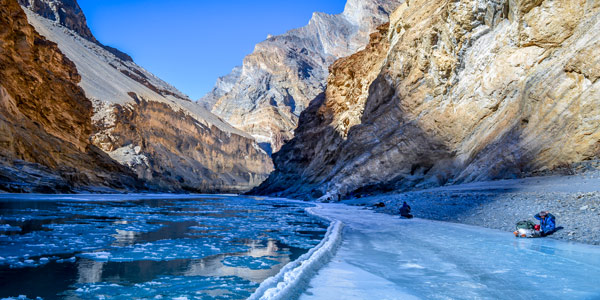
Hikers follow the frozen river banks along the Zanskar to get the best purchase on hardening ice as the mountains close in nearing the gorge. In 2020 the passage was restricted to 100 persons a day. That has all changed now with a new road passing through the valley. HOW difficult could a 45km hike, on a frozen river be? At a height of nearly 11,000ft, along the picturesque Zanskar Valley, meandering through a land where snow leopards sleep? Where winter temperatures dip to minus 24 degrees Celsius? And where mountain walls are as cold as ice and, should you fall, the water below is even colder? Not hard at all. Travellers of all persuasion are known to visit these remote spots in the northern reaches of the Indian Himalayas, tucked between Kashmir and Ladakh. It is a great summer getaway and Zanskar whitewater rafting is a huge adrenalin rush. Yet, in the depth of winter when saner people huddle over crackling fires around the living room hearth, we met an astronomer, solo trekkers, large tourist groups determined to acquire terminal frostbite, and petite young wives with doddering husbands. Not all were enamoured of the Big Chill when the iced river surface (colloquially referred to as “chadar”, Hindi for sheet) facilitates direct travel on foot. Porters told of a “chatty Indian woman” who, upon encountering her very first obstacle, demanded a full refund. And then there was the elderly Japanese couple who slipped so often on the ice that they quit in three hours flat.
At least one trekker considered calling in a rescue chopper, an exercise that would flatten any corporate wallet with its over US$4,500 heft. And that distress call would have to be passed word of mouth right up to Leh, Lingshed or Padum, where phone lines actually work. Tough? Nah. The numbers - and attendant pollution - have grown, alarming purists and eco-warriors. With the government stopping the chadar trek mid-February 2020 and travel agencies issued formal instructions to keep the numbers through the gorge to 100 per day there was hope for regeneration of the land. The Zanskar gorge had a brief respite. With the completion of an excellent black-top road linking Kargil to Padum and on to Manali in Himachal Pradesh, this seems a distant memory. The chadar treks are back and glorious summers beckon visitors to this remote and beautiful Himalayan valley. A winter Zanskar frozen river trek is one of the most expensive hikes India has to offer for men who will be boys. For the people of the region who live in medieval villages, a frozen river was a preferred shortcut to civilization. The only alternatives were the dangerous switchback trails wandering up and down the mountain passes. 
Trekkers cross Lago La (far left) as they head down from the pass towards Panikar; (Left centre) Fancy lunch by Ibex; Kargil-Manali highway (centre); Right, Mandip Singh of Ibex surveys the route ahead/ photos: Ibex Expeditions The new road that was opened 19 May 2024 will have a huge impact on local lifestyle. Visitor numbers are up again. For those who enjoy wheels (on their own or with a tour group), the drive from Kargil in the north down to Panikar (where camping and rest is to be found) just before Rangdum, will take around five hours. After the stark Rangdum Monastery, passing the twin peaks of Nun and Kun, it is a further five-hour drive to the district capital of Padum. From Padum it is a five-hour drive on up to Darcha on the Leh-Manali highway and four hours more to overnight at Keylong. Finally, from Keylong the new tunnel bores through the mountains to get you to Manali in about four hours, bypassing the Rohtang Pass and its many switchbacks. School-going children use the frozen river to hop and skip between villages. Local women, six months pregnant, trek to hospitals as far as Leh in three days flat. The road has sped things up for them and brought health and education closer. In comparison, the average trekker covers the same distance over four days or more. This is not the stuff of your average Zanskar fun guide but it is piquantly different. Trekking companies charging as low as Rs18,000 (about US$215) offer eight to nine-day 'chadar treks' including acclimatisation time in Leh, a medical check to certify hikers, transport to roadheads, meals, camps and guide services. This has made the trek more accessible but had resulted by January 2020 in crowds, bottlenecking, and delays much to the frustration of operators and trekkers. Companies with excessively low rates may be unable to match international safety standards and this should be kept in mind. Luxury companies offering better guides and higher safety standards as well as quality lodgings charge from US$1,000-US$3,000. The long running and highly acclaimed Ibex Expeditions (www.ibexexpeditions.com/) helmed by the indefatigable adventurer, explorer, and mountaineer Mandip Singh Soin (assisted by his charming wife Anita and two adrenalin-junkie kids) is a qualified high end operation that might charge upwards of US$3,000 per person (minimum two) with quality guides, top-notch accommodation and quality meals and campsites with a high level of comfort. Ibex has a keen eye on sustainability and is engaged in several green initiatives for 'responsible tourism' in the high Himalaya. Jeep safaris from Kargil to Manali snaking through Zanskar Valley are an exciting newer addition for those short on time. Stanzin Odzer of Ecological Footprint manages 10-day walks Chilling to Padum with "overnights in caves and walks on the frozen river in -30C weather." Shorter 9-day hikes (including a three-day acclimatisation in Leh) with a five-day walk to Nerak are sometimes available. A longer Linshed trek adds three more days to the itinerary. Send us your Feedback / Letter to the Editor So what kind of trekking gear must one carry for this arduous undertaking? Local guides swear by Mammut winter wear, and Northface equipment. They don’t use (and can’t afford) either themselves, but you’ll find plenty of Chinese rip-offs in Leh (the capital city of Ladakh). More original alternatives are found in Delhi or Mumbai, where at least Quechua gear is easily available. 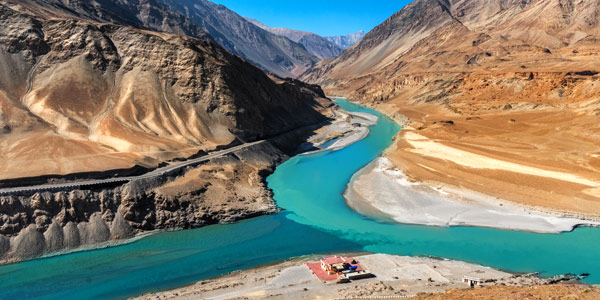
The confluence of the muddy Indus River with the turquoise blue waters of the Zanskar offers a stunning sight just before the road gets to Nimmu village. Polyester ski pants guard against moist and cold winds (unlike cotton, they soak less and dry fast), and you’ll need at least two jackets – a warm feather jacket for the evenings and a fleece during the day. Thermals, thin and thick mitts, light thermal flask for a bottle, walking stick and at least a dozen warm woollen socks are a must. Also gumboots, a size larger, to allow enough space for an extra layer of woollen socks. Buy a muffler and defogging glasses to guard against sun glare and the snow's reflection. Carry dry fruits and lots of chocolates. Cameras and torches need back-up batteries as they drain faster in sub-zero temperatures. Like newborn babies, keep batteries close to your chest and warm at night. Carry medicine for every common illness you can think of. And consult a doctor before you venture up. Getting there — we got in a few years before the road arrived — was in itself an adventure. We arrived in Leh, and its breathtaking views mid January. Built by the army, Leh airport is small and heavily guarded. On your journey back you must check in even small backpacks, and batteries must be separated from cameras – the latter carried by hand. The only cabin concessions are a backpack full of camera equipment, or a lady's purse. For many, this may be the hardest part of the expedition. There is also an older highway from Manali (in Himachal State) that ends in Leh, but people rarely drive up during the winter. Heavy snowfall blocks roads for weeks. Some have had to sell their cars in Leh as a result. It is necessary to stay in and rest on day one of your trip, so as to acclimatise to Leh’s altitude of an average 9,000ft. Without rest, altitude sickness will ruin every day and night that follows. It is an unhappy cocktail of dizzy fatigue, headaches and tummy wobbles. Electricity supply in Leh is erratic at best so charge your batteries constantly. And expect wet wipes and sunscreen lotions – any concoction with liquid in it – to turn to ice. Unlike the frozen river trek, rafting is a more popular sport during the summer months. Tour operators offer expeditions along the Zanskar and Indus Rivers. Chilling, where the uphill frozen river trek begins, is the same place where river rafting along the Zanskar ends. Rimo Expeditions and Aqua Terra are among the better known tour organisers in these areas. We travelled with Peak Adventure, a [Delhi] Noida-based tour organiser that has been around since 1989. But, as we learnt the hard way, organisers of such trips in faraway Delhi suffer from some serious drawbacks. While Delhi is responsible for marketing and payment collections, the trek is conducted by other Leh-based agencies that may not deliver on all the sales promises. Our meals were meant to be “a mix of Indian, Chinese, Continental and Ladakhi”. What we got were meals for vegetarians made from pasta and penne from instant-food packets. Indian and Ladakhi food were on the menu, but made only rare appearances. The highlight of many forgettable meals remained that old MSG-infused staple: Maggi noodles. It is maybe unreasonable to expect freshly cooked meals on a trek like this. But our itinerary – prepared by someone who had never been there before – served up a host of errors. (Admittedly this was a while back and standards at several tour companies have vastly improved. But do check. As a rule, most companies prefer to stick with purely vegetarian meals.) 
Mandip Singh, Ibex Expeditions pioneer and explorer pauses coming down Pensi La (pass) after Rangdum with the silver glacier (below) and headwaters that lead to the Zanskar River/ photo: Ibex Expeditions Campsite Zaribago got replaced with Tsomo. A stayover at Chilling was skipped altogether. “Coppersmith workshops” in Chilling were closed because there happened to be just one solitary workshop open in the village. A “one hour walk” turned into a steep, four-hour climb. And nobody – not even the competition – warns you about Umah (but more on that later). I am told the itineraries have been subsequently overhauled. Old timers in Leh say that if you want impeccable service, go to Project Himalaya. Project Himalaya offers just one 20-day frozen river trek between Chilling and Padum. As one of the longest options on offer, this Zanskar trek is priced high. Agencies like Peak Adventure charge a fair bit as well for a 'tough' 12-night trek (including Ladakh sightseeing as to Thikse and Hemis monasteries) mid-January to mid-March between Lingshed and Chilling. Ibex Expeditions is a high quality company with a solid history and offers, chadar treks, mountain climbs, rafting, mountain biking, and even homestays and snow leopard spotting trips. While Chilling is the starting point for all hikes in the region, there are different treks and paths to be taken, all of which vary in degrees of difficulty and duration. The strongest of heart will trek for 10 days to Padum, the largest town in the Zanskar region. A second option takes you to Lingshed over a shorter, five-day trek. Lingshed is an old, 85-mudhouse village situated at roughly 12,000ft and, unlike on the Padum route, you have to leave the river and start climbing up a frozen stream to get there. The most popular Zanskar winter trek, however, is the shorter three to four-day trip between Chilling and Nyerak. Our most memorable moments on our Zanskar frozen river trek however were found well beyond Nyerak. The relative danger on treks up to Nyerak is far lower, but so too is the fun. Press on for enlightenment. The larger the group, the more pressure put on the icy hiking paths. Smaller groups are more likely to cross spots where ice formations are weak; while larger groups simply won’t risk it. They are more likely to camp the night – we saw this happen – only to return home the next day, irrespective of the distances promised on paper. This is one area, where Peak Adventure has got it right. We were three trekkers, with eight porters, a guide and chef. We arrived perfectly on time, well before the competing crowds. Our ice was fresh and unbroken all the way to Lingshed. You cannot attach a price to such luxury. On day one we rested in Leh while day two offered some excitement. Most tour operators accommodate acclimatisation time by visits to monasteries on the second day. We travelled to the monastery in Hemis, and then to Thiksey and Shey on the way back. If planned well, the trek can be timed with local celebrations (leh.nic.in) held at some of these monasteries. On day three with our belongings packed, we met with our guide and chef at 9am. Regular sleeping bags do not keep out the cold at such low temperatures, so we rented more sturdy gear at US$3 (Rs150). Indian Army sleeping bags rented out in Leh are bulky and double layered. Not only do they work fabulously well, but you won’t even need to carry them, as porters inherit that unenviable task. The road to Chilling is a three-hour drive on a road that cuts through desert landscape. We passed Magnetic Hill along the way, and the confluence of the Zanskar and the Indus rivers around Nimmu village. Five rivers, including the Zanskar, empty into the Indus which twists and turns till it reaches Pakistan. Glimpses of the frozen river begin to appear after the passes at Nimmu. Large swathes of white ice sheet along the valley, for kilometres at a stretch, make sudden appearances. It’s a scene straight out of Narnia. Energy levels within the car started to soar. Ice on the Zanskar River begins to freeze in December. By January the ice is on average four feet thick with areas solid enough to carry loaded trucks. In Chilling, a team of eight porters met us. We were all set for our Zanskar frozen river trek. 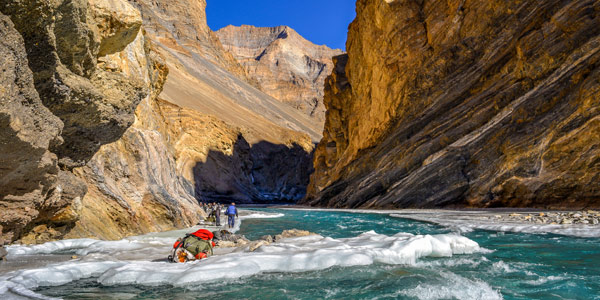
The Zanskar River gorge narrows at Nyerak (also Naerak) as mountain peaks cast sun-dial shadows across the rust valley with its slivers of coloured mineral rocks. Porters are farmers by summer, and hiring one during those months is more expensive than in the winters. More than 2,500 men from Zanskar are employed on the river during the winter months. They charge upwards of US$10 (Rs700) per day – and bring their own supplies including food, stove and kerosene. The first steps on a frozen river can be a tough balancing act for anyone. You must hope that snow will fall for you in the right quantities. Too little snow makes the ice tough to walk on. Too much snow, on the other hand, makes it harder to identify thick from thin ice. Falling on ice hurts hardest on the rear, and you must be extra careful on thin ice. There’s a trick to walking on ice: to walk you don’t lift your legs at all. Instead, like skating you simply slide them from side to side. Despite the temperatures, the cold won’t hit you while walking – an average five hours a day. In fact, dressing up too much will leave you sweating under the jacket. It is freezing cold only when camped – and especially so during the evenings and early mornings. From Chilling we headed to our first camping ground of Tilatdo, which is barely a one hour walk. This is the shortest walk of the trek, and partly allows for a third day of acclimatisation. A group had beaten us to a solitary cave at Tilatdo. So we camped out in the open, which was not necessarily a bad thing. While a cave protects you from cold winds outside, and possible rock slides at night, trekkers and porters also light bonfires in them – causing ash and soot to fly all over the place. On the other hand, tents can be strategically placed around boulders – further away from mountain walls – which offer sufficient protection from cold winds. What cannot be avoided, however, is the accumulation of moisture within the tent. Warm air rises to the tent’s roof, where cold air on the outside causes moisture to form droplets on the inside. By morning there are loose crystals of ice on the inside of the tent’s roof. Moisture’s effect on the sleeping bag is radically different around the face area – it turns into water, leaving the bag with large, wet patches by morning. This is, perhaps, the most annoying natural occurrence on the trip. You will find yourself waiting to dry your belongings – shoes, sleeping bags and smelly socks – as soon as the sun is up. We also soon accepted that the fun of this trip lies in the walking, however arduous. It’s a constant battle, adjusting your speed with that of the guide's. Porters, cooks and guides get paid by the day, and the trek isn’t a holiday to them. While following your guide is a strict rule, it took some argument, and coaxing, to get the guide to quit racing. He "walked" with us for the rest of the journey. There’s a good 13 hours of darkness in between daylight hours, a large part of which must be passed in sleep. At times like these, having a companion helps. A pack of cards or maybe a book to read. We woke up every morning to a glass of warm water. Then the breakfast. Eggs, bought in Leh, had been cracked open and yolks and whites packed into a bottle for the rest of the trip. Breakfast starts with tea, coffee, hot chocolate or milk, and a warm soup, followed by either sweet pancakes, scrambled eggs or jam with rotis. Your porters will not eat before you do. This is emotional blackmail. You must wake up early if only to keep the team from staying hungry. By 9am we were all set to go. The guide changed the itinerary and we headed to Tsomo instead of Zaribago. We were told Zaribago required a detour. Tsomo, however, was no disappointment. This is a waterfall that emerges from a tiny opening in the mountain wall. Unlike all other waterfalls in the area, it is fed by a hot water spring somewhere deep within the mountain. In a vast expanse of ice and snow, Tsomo looks magical and never freezes. 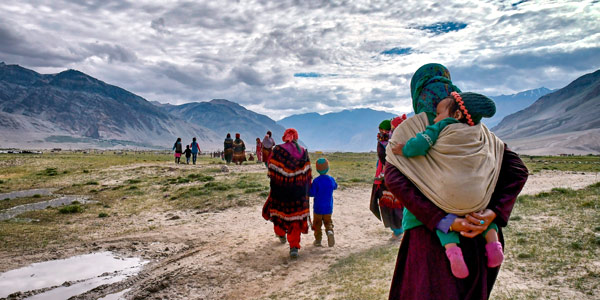
Ladakhi women attired in colourful robes cart their children to Padum to listen to monks and offer prayers as summer starts to beckon and the snows recede. Early next morning we were up and ready to head towards Deep, which took about four hours to get to. By now, we had crawled under mountains on ice two feet wide, and walked on ice sheets that stretched till the horizon. This was also the only stretch where we spotted snow leopard pugmarks. And it was as lucky as we would get. It is difficult to imagine someone spotting a snow leopard in the open, camouflaged as it would be against the white of the landscape. These leopards also stay clear of humans, and will step down to cross the river only late at night. Wildlife enthusiasts camp for 15 days at a stretch, hoping for a lucky day when a leopard may surface for an hour or two. The highlight that evening was a noisy avalanche. Ten minutes after we had camped at Deep we heard rumbling sounds from behind. The avalanche, which went on for the longest two minutes, caught everyone’s attention. By the time it passed, the ice sheet below had been torn to bits. Our destination the next morning was Nyerak (also Naerak), where we saw the first sign of human settlement, and a shop. There’s a century-old juniper tree along the way, called Shukpa, laden with prayer flags. It is far bigger than any of the other shrub-size trees you’ll find along the way. The Shukpa’s dry, tiny, needle-point leaves smell of incense when burned; and they are used as prayer offerings at Buddhist monasteries. On the way to Nyerak we also passed a massive frozen waterfall, distinctive by its twin outlets. Nyerak was something else. We met the octogenarian Bullu here, who built his mud house above the banks of the river 50 years back. Bullu travels down to the river every morning to fetch his water, collects dry wood and stays alone. He speaks more than four languages and hasn’t fallen ill, not even a cold, in over a decade. That night we bought bottles of rum at thrice the price in Leh, chocolates, and packets of biscuits for the porters. In return they took us to a local peak that offered a bird’s-eye view of the river below. For about $10 (Rs700), for the first time in days, we slept in a rented mud room atop the peak. Early next morning, we began the last leg of our trek to Lingshed. Twenty minutes into the walk from Nyerak is a spot called Umah. Though the river flows eerily slowly here, ice formations are always weak as there is a hot water spring below. The army has fitted iron rods into the mountain walls here, at more than one location, should the ice disappear altogether. We were lucky, with the ice formation that day. The ice creaked louder than usual as we passed by, but it held strong. We had passed our first test. An hour later, for the first time, we parted ways with the river (trekkers to Padum continue on along its banks). From here we began a steep four-hour climb along a frozen stream right up to Lingshed. For the first time also, we switched our gumboots for fancy shoes. You need them on the mountains, with their better grips for climbing. The climb is tiring, on a muddy path that winds through avalanche prone territory. These narrow paths curve along high mountain walls. You’re constantly climbing a valley where yaks graze. There are times where the path is covered with frothy ice (caused by snow slides), or there is no path at all. The effort was well worth it when we finally reached Lingshed – sapped of all energy. That evening we stayed back for an extra day in the cosy comfort of a one-storey house with large glass windows that allowed for a lot of sunlight. Lingshed is a village lost in time – it has monasteries for nuns and monks, and a school for children till the 10th standard. Lingshed also has – hold your breath – a satellite phone. Run by the Indian government, charges here are subsidised. But it works on solar power (pray for some sun) and you have to stand in line. 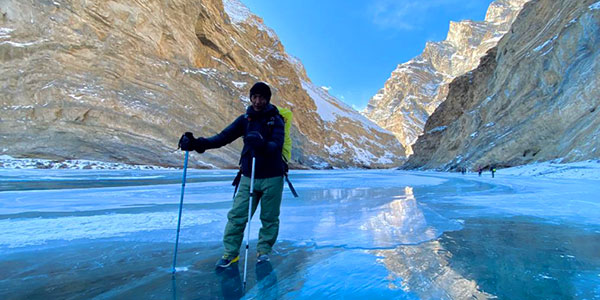
Stanzin Odzer of Ecological Footprint pauses on the 'chadar' sheet ice covering the Zanskar River as morning light pours through the valley/ photo: Stanzin Odzer Lingshed’s villagers rear ponies, donkeys, yaks and furry goats. They offer a room in their homes for US$20 (Rs1,400) a day, and their hospitality and love for visitors is unadulterated. Random passersby will invite you over for lunch or dinner. You wake up in the mornings to donkeys braying, horses neighing, yaks snorting. Lingshed has been in existence for over a thousand years. That night, the porters assembled around a large bonfire for a dance that would last till early morning. The return from Lingshed, a constant descent, turned out to be a lot faster than travelling up to it. We covered the journey to the frozen river – which took us over four hours earlier – in under an hour, and spotted a few ibex along the way. We got delayed, however, at Umah. On a bad day, Umah can test the nerves of trapeze artists. We were no slouches by the time we had negotiated the broken ice and helpfully placed iron rods. We reached Nyerak late afternoon, tired but safe. The journey onwards from Nyerak was speedy. We chose to spend our final night at Tilatdo. On the drive back to Leh, our guide commented, "Sir, you are all weak". No insult was intended. And none was taken. After days of toil and frozen endeavour, I felt like Superman. We all did. SHould limitations on the chadar trek be in effect post-2020, explore this beautiful valley in summer with shorter trips that are more family-friendly and less taxing. Send us your Feedback / Letter to the Editor FAST FACTS / Chadar trek informationGeneral: The winter Chadar Trek on the frozen Zanskar River was shut down by the local government from 12 February 2020 as an ecological measure to help bring temperatures down to enable surface freezing that facilitates vital direct travel for local villagers. The chadar sheet used to stay in place January to February but by 2020 most treks had to rethink as just the sides of the river were frozen causing traffic jams and delays. Names: Nyerak is also called Nyerakpulu (or Naerak), Deep is called Deekyokma and Tsomo is called Tsomopaldar. But very few people call them by these names. Exchange rate: US$1 = Rs84. Trek organisers tend to have separate charges for non-Indians, usually denominated in euros. Bring small denomination Indian rupees with you if possible. Credit cards are not customarily used in Ladakh, although some better hotels do accept them. There are a few moneychangers in the market and some bigger banks. It is customary to tip people who help you: tour guides, waiters, porters, and drivers. Safety: It is advised to register personal information and plans your embassy. Buy travel insurance that covers the cost of helicopter rescue. While the cost of a helicopter evacuation is about Rs100,000 one way, you must pay for a two-way trip. Trekking and camping permit: The frozen river trek does not need one. But treks along several mountain ranges, especially along the Indian borders, need "inner line" permits. The cost ranges from Rs100 to Rs1,500 and more, and hotels and guesthouses can arrange this for a fee. Renting gear: Some organisers charge a small sum per day for a double layered, sleeping bag. Depending on your package and negotiations, others offer it for free. There's a fixed charge for hiring protective gaiters for the legs. Gumboots can be purchased from the market for about Rs500. Yak wool socks can be picked up too. Walking sticks are at times part of the deal, and must be returned when the trek ends. 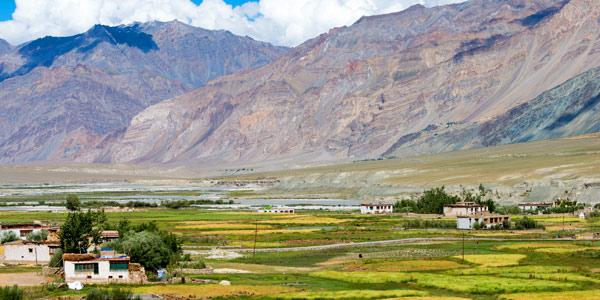
Summer brings green field patchworks to life as villages from Karsha to Padum get to work to prepare their harvests for the long cold winter ahead. Photography: Photo-taking at monasteries is usually permitted. But taking pictures with a flash is strictly prohibited. There is also no entry fee for monasteries. See our Ladakh fun guide. For more information visit Leh's official website at leh.nic.in/. Also Reach Ladakh (reachladakh.com/). The Incredible India (www.incredibleindia.org) website has some interesting material and visuals on Ladakh and Leh. Zanskar frozen river Chadar Trek operatorsEcological Footprint. (www.ecologicalfootprint.in/). Zanskar whitewater rafting agenciesAqua Terra. Tel: [91-11] 2921-2641, 2921-2760, (aquaterra.in/).
NOTE: Telephone and fax numbers, e-mails, website addresses, rates and other details may change or get dated. Please check with your dealer/agent/service-provider or directly with the parties concerned. SmartTravel Asia accepts no responsibility for any inadvertent inaccuracies in this article. Links to websites are provided for the viewer's convenience. SmartTravel Asia accepts no responsibility for content on linked websites or any viruses or malicious programs that may reside therein. Linked website content is neither vetted nor endorsed by SmartTravelAsia. Please read our Terms & Conditions. |


